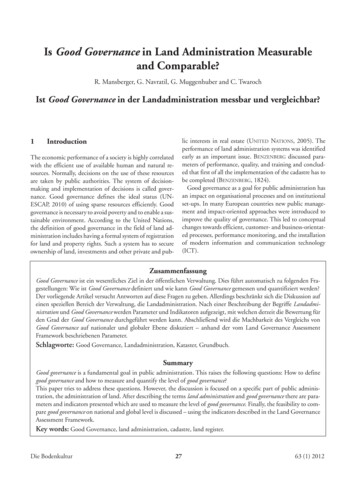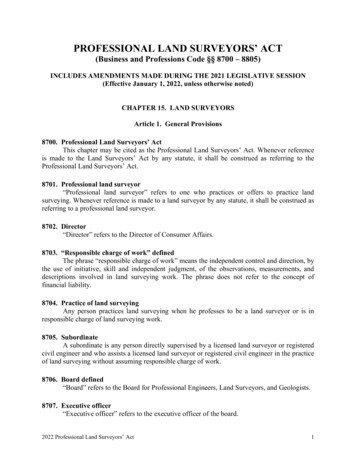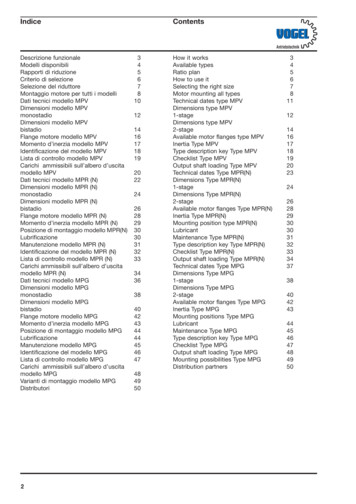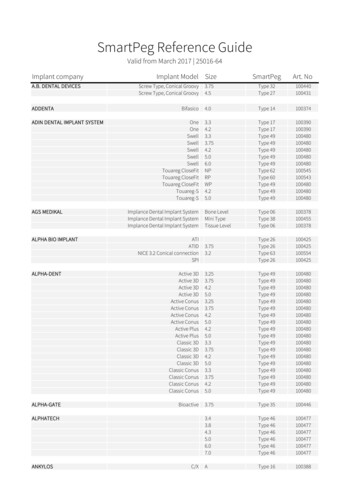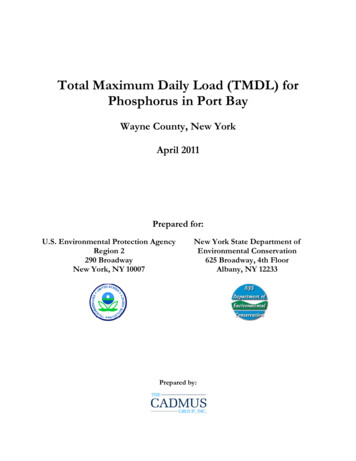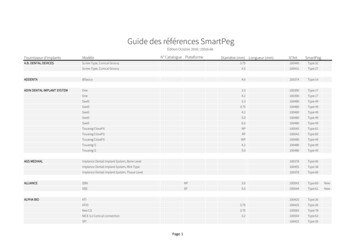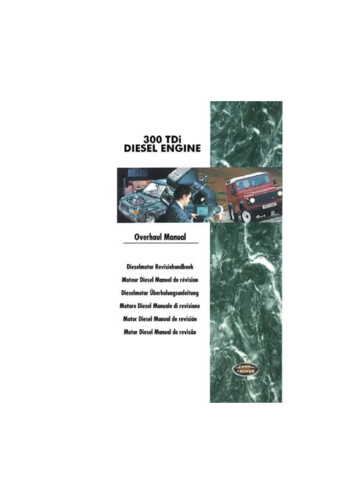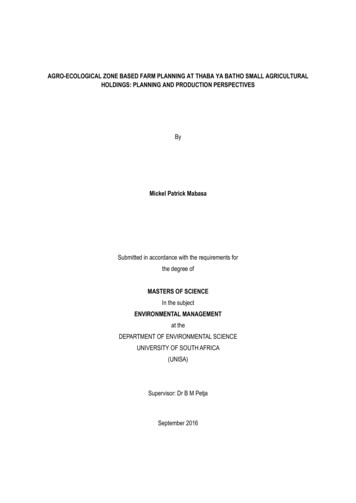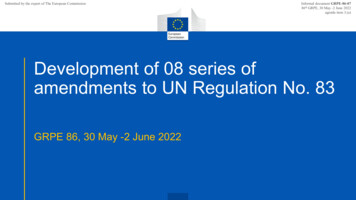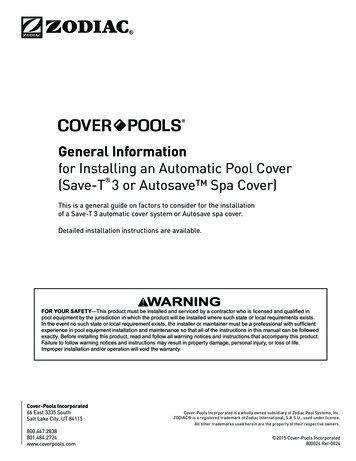
Transcription
remote sensingArticleReconstructing Historical Land Cover Type andComplexity by Synergistic Use of LandsatMultispectral Scanner and CORONAAmir Reza Shahtahmassebi 1, *, Yue Lin 1 , Lin Lin 1 , Peter M. Atkinson 2 , Nathan Moore 3 ,Ke Wang 1, *, Shan He 1 , Lingyan Huang 1 , Jiexia Wu 4 , Zhangquan Shen 1 , Muye Gan 1 ,Xinyu Zheng 1 , Yue Su 1 , Hongfen Teng 1 , Xiaoyan Li 5 , Jinsong Deng 1 , Yuanyuan Sun 1and Mengzhu Zhao 112345*Institute of Agricultural Remote Sensing and Information Technology, College of Environment and NaturalResource, Zhejiang University, Hangzhou 310058, China; joyelin2017@163.com (Y.L.);linlinchn@zju.edu.cn (L.L.); heshan33@zju.edu.cn (S.H.); joy okey@163.com (L.H.);zhqshen@zju.edu.cn (Z.S.); ganmuye@zju.edu.cn (M.G.); zhengxinyu@zju.edu.cn (X.Z.);ysu@zju.edu.cn (Y.S.); tenghongfen@163.com (H.T.); jsong deng@zju.edu.cn (J.D.); yysun@zju.edu.cn (Y.S.);zhaomengzhu16@zju.edu.cn (M.Z.)Faculty of Science and Technology, Lancaster University, Bailrigg, Lancaster LA1 4YQ, UK;pma@lancaster.ac.ukDepartment of Geography, Michigan State University, East Lansing, MI 48823, USA; moorena@msu.eduDepartment of Atmospheric Oceanic and Earth Science, George Mason University, VA 22030, USA;jwu14@masonlive.gmu.eduDepartment of Earth Science, Jilin University, Changchun 130061, China; lxyan@jlu.edu.cnCorrespondence: amir511@zju.edu.cn (A.R.S.); kwang@zju.edu.cn (K.W.);Tel.: 86-571-8898-2297 (A.R.S.); 86-571-8898-2272 (K.W.)Academic Editors: Chuanrong Zhang, Magaly Koch and Prasad S. ThenkabailReceived: 2 May 2017; Accepted: 29 June 2017; Published: 3 July 2017Abstract: Survey data describing land cover information such as type and diversity over severaldecades are scarce. Therefore, our capacity to reconstruct historical land cover using field data andarchived remotely sensed data over large areas and long periods of time is somewhat limited. Thisstudy explores the relationship between CORONA texture—a surrogate for actual land cover typeand complexity—with spectral vegetation indices and texture variables derived from Landsat MSSunder the Spectral Variation Hypothesis (SVH) such as to reconstruct historical continuous landcover type and complexity. Image texture of CORONA was calculated using a mean occurrencemeasure while image textures of Landsat MSS were calculated by occurrence and co-occurrencemeasures. The relationship between these variables was evaluated using correlation and regressiontechniques. The reconstruction procedure was undertaken through regression kriging. The resultsshowed that, as expected, texture based on the visible bands and corresponding indices indicatedlarger correlation with CORONA texture, a surrogate of land cover (correlation 0.65). In terms ofprediction, the combination of the first-order mean of band green, second-order measure of tasseledcap brightness, second-order mean of Normalized Visible Index (NVI) and second-order entropyof NIR yielded the best model with respect to Akaike’s Information Criterion (AIC), r-square, andvariance inflation factors (VIF). The regression model was then used in regression kriging to maphistorical continuous land cover. The resultant maps indicated the type and degree of complexity inland cover. Moreover, the proposed methodology minimized the impacts of topographic shadow inthe region. The performance of this approach was compared with two conventional classificationmethods: hard classifiers and continuous classifiers. In contrast to conventional techniques, thetechnique could clearly quantify land cover complexity and type. Future applications of CORONAdatasets such as this one could include: improved quality of CORONA imagery, studies of theRemote Sens. 2017, 9, 682; nsing
Remote Sens. 2017, 9, 6822 of 23CORONA texture measures for extracting ecological parameters (e.g., species distributions), changedetection and super resolution mapping using CORONA and Landsat MSS.Keywords: historical land cover; CORONA; Landsat MSS; land cover type; land cover complexity;spectral variation hypothesis (SVH); image texture; regression kriging1. IntroductionOne of the most important drivers of global environmental changes is anthropogenic land useand land cover change [1]. A clear understanding of land cover over time is crucial to forecast futurechanges and effectively manage ecosystems [2]. Therefore, reconstructed historical land cover mapshave long been recognized as an important source of information for both scientific research (e.g.,change detection) and to support environmental decision-making (e.g., conservation planning) [3].Furthermore, appropriate spatio-temporal data on historical land cover may help scientists andmanagers understand the reasons for land cover change, investigate the impacts of land use policiesand provide consistent land cover statistics. Numerous international research centers and programs,such as the U.S. Geological Survey (USGS), have prioritized the development of systems to reconstructhistorical land cover maps in intelligent ways. Remote sensing has emerged as the most useful datasource for generating historical land cover maps [4–6].Landsat archive data, particularly from the Landsat multispectral scanning system (MSS) sensor,have been used for producing historical land cover maps because this archive contains unique, andnow irreplaceable, information about the historical state of land cover on the Earth’s surface [7].In addition, these data are freely available to the global community via the Internet from the USGS.Efforts to generate historical maps of land cover have involved classifying remotely sensedspectra into thematic maps which commonly are formed of discrete land cover classes depicting broadland cover types [8]. While such approaches have yielded encouraging results, discrete classificationmight be inappropriate. This is partly because such processing results in a loss of information andpartly because smooth transitions between land cover classes cannot be represented adequately [9,10].Specifically, discrete classification techniques assign each pixel in a remotely sensed image to a singleclass, which results in a loss of information [11]. This is true when the “objects” in the scene of interestare both large (high resolution or H-resolution case) and small (low resolution or L-resolution case)relative to the pixel size [12,13].To minimize the limitations of hard (or discrete) classification techniques, two common methodshave been suggested: the so-called “soft” classification model (here used to mean proportion predictionin general) and the calibrated post-classification model. Soft classification techniques estimate theproportion of each class within each pixel using, for example, spectral mixture models or fuzzyclassification [14]. Calibrated post-classification models can increase the accuracy of area estimatesfrom remote sensing, assuming that the relationship between the true and estimated proportions canbe modeled [13].The above techniques may be used to provide a land cover proportions map that is both moreinformative and potentially more accurate than the equivalent discrete classifiers. In addition to thesebenefits, non-discrete classifiers can provide more accurate parameter estimates for ecosystem andclimate change monitoring and detection. However, while the proportions of each class within eachpixel may be estimated more accurately than using hard classification, these methods have someshortcomings that may affect the performance of land cover mapping particularly for historical data.The accuracy of soft classification methods depends on the spectral resolution of the satellite sensordata, which may affect the ability to discriminate different land covers. For example, the similarity inthe spectral properties among non-photosynthetic vegetation, soil, and various impervious surfacematerials can make it difficult to distinguish impervious surfaces from pervious materials. Thus,
Remote Sens. 2017, 9, 6823 of 23applying soft classification may lead to over-estimation or under-estimation of the total area ofimpervious surfaces [15]. This is especially true for early satellite sensors, such as Landsat MSS, whichhas a coarse spectral resolution (a broad band multispectral sensor). Calibrated post-classificationmodels are applied in a sequential methodology; thus, the accuracy of each step may affect subsequentsteps [16].An alternative approach to generate informative continuous historical land cover maps uses thespectral variation hypothesis (SVH) [17]. This model assumes that spatial patterns of reflectance inremotely sensed imagery are likely to be correlated with spatial variation in biodiversity. Hence, spatialpatterns of reflectance in a remotely sensed image can be used directly to provide information on theenvironment, without classification. It is noteworthy that the SVH was used initially to examine thecorrelation between plant species diversity and spectral variation derived from airborne panchromaticimagery [17].The SVH could be used to generate land cover maps that include land cover type and complexity(heterogeneity and homogeneity) using two important sources of variation: spectral variation andspatial variation. As such, the conceptual SVH model may be implemented by using geostatisticaltechniques and texture measures [4,18,19]. Image texture is an important component of remotely sensedimages. Texture, often refers to spatial variation in the brightness of an image (e.g., radiance, reflectance)and is due to spatial variation in one or a mix of the land surface, atmosphere or sensor field of view [20].Land-cover classes may have different textures in remotely sensed images and the similarity anddifferences between texture and spectral brightness have great potential for characterizing land coverpatterns, predicting land cover diversity and increasing land cover classification accuracy [8,21,22].Geostatistics is based on the Theory of Regionalized Variables (TRV) and is applied extensively topredict values at unobserved locations. Geostatistical prediction uses the observed spatial dependencebetween data, represented by the variogram model or a similar function (which can be thought of as atexture measure), to minimize the linear model prediction error and produce zero bias [23,24].While the SVH is valuable for mapping biodiversity, this hypothesis has two limitations forgenerating historical land cover maps. Firstly, the main focus of SVH is tracking biodiversity, whileclassification of remotely sensed images into land cover, particularly continuous classification, is notwell addressed. Secondly, field data are the priority of the SVH model for building the relationshipwith remotely sensed images. This is a challenging task, and in some cases impossible, when historicalcontinuous land cover maps using earlier sensors, and specifically Landsat MSS.Given the above, historical maps or historical archives of aerial photos can be used as a surrogateof ground-based land cover information (e.g., pattern, type, complexity). Thus, the combination ofaerial photography, satellite sensor imagery and historical maps could be used for reconstructinghistorical land cover maps particularly under the SVH hypothesis [17,25]. Recently, the United Statesfine spatial resolution military surveillance satellite sensor known as CORONA has received increasingattention [7,26,27]. The CORONA data were acquired in the period 1961–1980 with a spatial resolutionof 1 m to 10 m in the panchromatic band, and were declassified in 1995 [28]. In addition, some parts ofthis data archive were made freely available to the global community via the Internet by the USGSenabling the scientific community to produce historical land cover maps.Previous studies have used CORONA imagery for mapping forest and land cover via conventionaltechniques such as hard classification [27,29], density slicing [28,30,31] and visual interpretation [32–34].A selection of these methods is presented in Table 1, which does not attempt a detailed review, butrather provides an overview of the variety of algorithms applied to the CORONA for extracting landcover and land use.
Remote Sens. 2017, 9, 6824 of 23Table 1. Selected studies, using CORONA imagery, that illustrate the variety of conventional techniquesused to the identify spatial distribution of land cover.Categories of StudyMapping ApproachObjectiveReferenceChange detectionChange detectionLand use/cover changeChange detectionClassificationLand cover mappingand cover changeLand cover changeHard classificationOn screen interpretationDensity Slicing techniqueVisual interpretationStep-wise density slicingSegmentationVisual interpretationISODATAImpervious surface mappingMapping pattern and dynamic of land coverMapping ForestChange of range landMapping land coverLandscape pattern featuresChange detectionChange detection[27][35][30][34][28][26][33][29]As mentioned earlier, such techniques might be inappropriate for land cover mapping. Severalstudies have suggested that CORONA imagery can be used as a surrogate for field data [36]. However,no studies have investigated the utility of panchromatic CORONA imagery as a surrogate for historicalfield data in the context of generating historical continuous land cover maps using Landsat MSSimagery under the SVH hypothesis.We contend that image texture derived from CORONA data could be used as a surrogate for landcover type and structure and be potentially valuable for reconstructing historical land cover. However,it is not clear how well the relationship between image texture in CORONA data with Landsat MSSvariables (spectral, vegetation indices and corresponding textures) can characterize historical landcover type and complexity. Furthermore, the potential of geostatistical techniques for predictingsuch land cover maps is unexplored. This is important because land cover type and complexity canoffer insights into habitat quality and diversity, which is may provide useful information for landmanagement applications.Our goal was to explore the ability of geostatistical techniques, applied to image texture ofCORONA data and Landsat MSS variables to reconstruct and map historical land cover type andcomplexity. The first objective of this paper was to assess the relationship between historical CORONAdata, as a surrogate for field data, and Landsat MSS data. The second objective was to evaluate theutility of this relationship for generating historical continuous land cover maps within a forestedenvironment. Based on the SVH, we investigated the hypothesis that spatial variation in the reflectanceof Landsat MSS is likely to be correlated with spatial variation in the reflectance of CORONA. Bymodeling this relationship, we aimed to generate historical continuous land cover type and complexity.Specifically, texture measures were employed to analyze the variation in reflectance in CORONA andLandsat MSS while a geostatistical technique (regression kriging) was applied for spatial prediction.2. Materials and Methods2.1. Geostatistical Analysis-Regression KrigingGeo-statistics is a set of methods aimed at characterizing and modeling spatial variability forprediction and simulation, and a range of other geostatistical operations [23,24,37]. In the context ofremote sensing, geostatistical methods extract spatial properties of regionalized variable (e.g., spectralreflectance) which can be used in image classification, allocation of spatial unbiased sampling sitesduring classification map accuracy assessment, and prediction of values at unobserved locations [38].One of the geostatistical interpolation techniques is Kriging. This technique includes a family ofleast-squares linear regression algorithms that are used to estimate the value of a continuous attribute(e.g., reflectance) at any unobserved location using weighting scheme where proximate samplelocations have a greater impact on the final prediction [38,39]. The weighting procedure is determinedby the variogram [39].Recently, much attention has been given to hybrid kriging interpolation methods which integratedifferent aspatial and spatial algorithms [23]. One of the hybrid kriging interpolation techniques
Remote Sens. 2017, 9, 6825 of 23is regression kriging (RK) which includes two major steps: modeling the relationship between theresponse and predictors variables, and then using simple kriging with known mean (0) to interpolatethe residuals from the regression model [23]. In mathematical terms, these two steps can be writtenas [23]: ẑ(s0 ) m̂(s0 ) e(s0 ) k 0 βk ·qk ni 1 λi ·e(si )p(1) where m̂(s0 ) is the fitted drift, e(s0 ) is the interpolated residual, βk are the estimated drift model coefficients (β0 is the estimated intercept), and the λi are kriging weights determined by the spatialdependence structure of the residual and where e(si ) is the residual at location Si . RK has been usedfor remote sensing problems such as estimating Leaf Area Index, and image fusion [23]. Results havedemonstrated the high potential of RK to characterize the relationship between the target and predictorvariables in remote sensing [23,24,37,39].In this research, the RK approach was conducted based on guidelines from previous studies thatconsisted of the following steps [23,24,37,39,40]:(1)(2)Different regression models are fitted to explore the relationship between CORONA as a surrogateof real land cover and Landsat MSS bands (this step is presented in detail in the next section).Moran’s I is applied to the selected regression residuals to quantify autocorrelation. The Moran’sI statistic for spatial autocorrelation is given as [39]: N in 1 nj 1 Wij Xi X X j X I 2 in 1 nj 1 Wij nj 1 X j X(3)(2)where, N is the number of spatial units indexed by i and j; X is the variable of interest; X isthe mean of X; and Wij is an element of the matrix of spatial weights. Moran’s I varies from 1 (large negative spatial autocorrelation) to 1 (large positive spatial autocorrelation). A zerovalue indicates a random spatial pattern. It should be borne in mind that if the residuals exhibitno spatial autocorrelation (pure nugget effect), ordinary least squares (OLS) estimation of theregression coefficients is applied; Otherwise, if the residuals exhibit spatial autocorrelation,regressing kriging is applied [39].The variogram of the residuals is used to determine the weights for spatial prediction (i.e.,weights applied to observed points that are spatially auto-correlated with the site to be predicted).The empirical variogram is computed from [39]:(4)γ(h) (5)(6)12nn (Z(xi ) Z(xi h))2(3)i 1where Z(xi ) is the residual value at location i, Z(xi h) is the residual value of other locationsseparated from xi , by a discrete separation vector or lag h; n represents the number of pairs ofobservations separated by h; and γ(h) is the estimated or “experimental” semivariance for allpairs of observations at lag h. Semivariances were calculated for each possible pair of observedlocations, and the mean values of the semivariances were plotted against lag magnitude intervals h to produce the experimental variogram of the regression residuals.The variogram is applied in Krige.The estimated trend is added back to the Kriged estimates in Equation (1).The gstat package was used to conduct the variogram analysis and regression kriging [41].
Remote Sens. 2017, 9, 6826 of 232.2.Building Regression Models2.1.1. Response Variable from CORONAThis study utilized CORONA imagery as a surrogate of ground-based land cover in forestedenvironment. The first-order-mean n texture statistic was calculated for the CORONA image, asa surrogate measure for the actual land cover type and its complexity. Hereafter, this measure isabbreviated to LC. The small texture values represent low complexity and variability in spectralcomposition of a sample region while large texture values indicate high complexity in that region [38].For example, forested regions may result in a low magnitude first-order-mean while urban regionsmay have a high magnitude. This texture measure was selected based on its established advantagessuch as characterizing vegetation cover, measuring heterogeneity, and ease of computation [9]. Wecomputed the first order measure, mean, within a moving window (25 25 pixels; 171 m 171 m;or 3 3 pixels on the Landsat MSS), and the texture measure was assigned to the central cell of eachwindow. This window size was selected to reduce the impacts of geometric errors associated with boththe MSS scene and the CORONA image.2.1.2. Explanatory Variables from Landsat MSSVegetation IndicesThe vegetation indices computed from the spectral reflectance of Landsat MSS in this researchwere grouped into three categories, visible, near infrared (NIR) and Tasseled cap. Visible band indicesincluded the S5 index which was the ratio of the red band (MSS5) to the green band (MSS4), andNormalized Visible Index (NVI):MSS5 MSS4NVI (4)MSS5 MSS4These indices are commonly used due to their ability to separate vegetation from non-vegetationcovers [38].NIR indices were divided into three classes: S6 the ratio of the NIR1 band (MSS6) to the red band(MSS5), S7 the ratio of NIR 2 band (MSS7) to the red band (MSS5), and the Normalized DifferenceVegetation Index (NDVI). It is noteworthy that the NDVI was calculated using MSS7 and MSS5. Theseindices are commonly used because of the relationship with the amount and health of vegetationpresent in an area, particularly useful for detecting vegetation differences [38].Finally, the Tasseled Cap (TC), which is linear transformation of the four MSS bands, wascomputed forming the third group. In addition to the TC bands (Greenness, Brightness, Yellow, andNon), we calculated two ratios: Greenness Brightness Ratio (GBR-ratio of Greenness to Brightness) andGreenness Brightness difference (GBD-difference between Greenness and Brightness). The TasseledCap bands provide the ability to detect readily the canopy, soil, and a mixture of these components [38].Texture MeasuresWe applied both first-order (occurrence) and second-order (co-occurrence) statistics. To computethe first-order statistics for a given scale of interest (e.g., a 3 3 pixel moving window), the pixel valueswithin the window were used to calculate the given statistic (e.g., variance), which was assigned tothe central pixel [42]. Second-order statistics consider the spatial relationships between neighboringpixels [42]. To calculate second-order statistics, the pixel values for a given scale of interest were firsttranslated into a gray-level co-occurrence matrix (GLCM). The texture statistics were then calculatedfor every pixel.To match the spatial resolutions at which the LC and image texture were represented, we applieda 3 3 window size for all image texture analysis [7]. This window size has the advantage of capturingthe heterogeneity of pixel values over small extents. Texture measures were selected based on theirestablished ability to characterize vegetation structure [42,43]. We calculated three first order texture
Remote Sens. 2017, 9, 6827 of 23measures (entropy, mean and variance), and four second order texture measures (mean, entropy,homogeneity, variance) using the Landsat MSS spectral bands and vegetation indices. The details andequations of texture measures are described in [42].2.2. Collecting Training Points250 stratified random samples were generated using the Random Point Tool in ArcGIS 10.2. Wecompared and examined carefully each sample point in the 1978 Landsat MSS and 1975 CORONAimages. Sixteen samples exhibited apparent changes in landscape composition and were, therefore,removed. A total of 234 samples were retained for use in the training model. Further, we used thetool “Extraction” in ArcGIS 10.2 to extract digital numbers of Landsat MSS variables (spectral bands,vegetation indices and textures) and the texture of the CORONA data based on these sample points.To avoid any confusion produced by topographic shadow, prior to applying the samplingapproach, we constructed a shadow mask identifying pixels belonging to shadow regions and excludedthem from the Landsat MSS and CORONA images. First, the shadow mask was constructed basedon the CORONA image using thresholding. Second, accuracy assessment was conducted to evaluatethe accuracy of the mask. The overall accuracy was found to be 95% based on cross comparison withvisual assessment. Then, the shadow mask was applied to the CORONA and Landsat images toremove shadowed regions.2.3. Statistical ModelingThe Pearson’s correlation coefficient was calculated between the response variable (LC) andexplanatory variables (Landsat MSS). Explanatory variables with a small correlation ( r 0.6) wereeliminated from the analysis.The response variable was regressed on the remaining explanatory variables. We selected the bestfitting models using the following conditions: (1) the smallest Akaike’s Information Criterion (AIC);(2) the largest r-square; and (3) explanatory variables had only a small correlation with other variables(i.e., measured using variance inflation factors(VIF) or with multi-collinearity less than 5). Modelselection was implemented using stepwise-VIF regression. In this technique, different combinationswere evaluated with respect to multi-collinearity. The variables with the largest VIF ( 5) were removedfrom the model until all VIF values of the explanatory variables fell below the given threshold. Then alinear model was created using the selected explanatory variables.2.4. Accuracy AssessmentThe performance of the models was assessed by leave-one-out cross-validation [6]. In thisprocedure, one observation is temporally removed from the dataset, and the remaining sample valuesare used to predict the variable. The cross-validation yielded a list of estimated values of LC paired tothose obtained from the observed sampling units. There are many different measures for checkingthe discrepancies between observed values and predicted values by cross-validation. The root meansquare error (RMSE), bias error (BE) and r-square were used to for assessment [24,37].In addition to cross-validation (to validate whether the model predicts well within the range andcharacter of the training data), random samples outside of the training dataset were used to evaluatethe accuracy of prediction [24,37]. We used 234 randomly selected sample points to examine theaccuracy of the results via the RMSE, BE and r-square.2.5. Comparison: Conventional Mapping TechniquesThe results of the proposed approach were compared directly to two major techniques: hardclassifiers and soft classifiers. Hard classifiers included two classification techniques: the supportvector machine (SVM) and density slicing. The support vector machine (SVM) was implementedto classify the Landsat MSS image into five classes: shadow, farmland, urban, mining and forest.The technical setting parameters of this approach were: Radial Basis Function for Kernel Type, Gamma
Remote Sens. 2017, 9, 6828 of 23in Kernel Function (0.33), Penalty Parameter (100.00), and Pyramid levels (0). The total numberof training samples was seven pixels for each class. Regarding density slicing, this technique wasperformed based on guidelines in [28]. The CORONA image was classified by the density slicingtechnique. The number and names of classes were similar to those for Landsat MSS.Remote Sens. 2017, 9, 6828 of 23In terms of soft classifiers, we employed spectral mixture analysis (SMA) and regression withoutkriging. SMAwas appliedto the LandsatMSS bandsto estimatetheanalysisproportionof forestand non-forestIn termsof soft classifiers,we employedspectralmixture(SMA)and regressioncover.withoutSMA portionshadow. ofDetailskriging.SMA was usingappliedthreeto theLandsatMSS bandsestimate theforestof ndmembers:forest,non-forestandSMA procedure can be found in [44]. Furthermore, the regression kriging procedure was in[44].Furthermore,theregressionkrigingthe CORONA and Landsat data with the major difference being that kriging and the variogram wereprocedurewasregressionapplied to model.the CORONA and Landsat data with the major difference being thatexcludedfrom thekriging and the variogram were excluded from the regression model.For the sake of clarity and brevity, we placed a condition for comparison between the resultsFor the sake of clarity and brevity, we placed a condition for comparison between the results ofof the different methods. Accordingly, if a careful visual interpretation could demonstrate that thethe different methods. Accordingly, if a careful visual interpretation could demonstrate that thedevelopedmethodis entwas notdevelopedmethodis preferableconventional techniques,techniques, numericalaccuracyassessmentwas notemployedfor accuracyevaluation.employedfor accuracyevaluation.2.7.StudyRegionand andData2.7.StudyRegionData2.5.1. 2.7.1.StudyRegionStudyRegionThe studyconductedthesouthernsouthern portionCounty,ZhejiangProvince,ChinaChinaThe el. ThereThere arelandcovertypes:forest,and andotherotherareas areasdue todue toto 1500m aboveare twotwodominantdominantlandcovertypes:forest,human activity (Figure 1). Forest regions are located in the mountains while the remaining landhuman activity (Figure 1). Forest regions are located in the mountains while the remaining land coverscovers are situated in the valleys. The main human activities are rural urban cover, mining andare situated in the valleys. The main human activities are rural urban cover, mining and agriculture. 50 22.6500 –119 80 52.1300 ) (Figureand119
remote sensing Article Reconstructing Historical Land Cover Type and Complexity by Synergistic Use of Landsat Multispectral Scanner and CORONA Amir Reza Shahtahmassebi 1,*, Yue Lin 1, Lin Lin 1, Peter M. Atkinson 2, Nathan Moore 3, Ke Wang 1,*, Shan He 1, Lingyan Huang 1, Jiexia Wu 4, Zhangquan Shen 1, Muye Gan 1, Xinyu Zheng 1, Yue Su 1, Hongfen Teng 1, Xiaoyan Li 5, Jinsong Deng 1, Yuanyuan .
